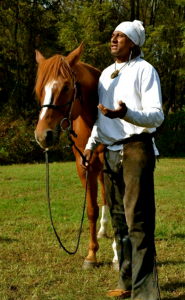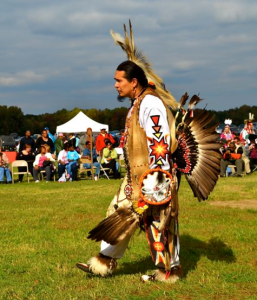Jordan Wright
October 27, 2011
Special to Indian Country Today Media Network
On an autumn afternoon with the sun at its apex in a clear blue sky, we traveled down a country lane to Maryland’s Patuxent River Park. Silhouetted against the deep green of the pines and American holly, the trees had begun their brilliant burst of color, the crimson of the dogwood, the lemon yellow of the tulip poplar and the pumpkin orange hue of the sugar maple. A tantalizing aroma of venison stew and fry bread hung in the cool crisp air, and cars had begun forming long rows in the freshly mown fields.
Set on 7,000 acres of protected woodland and watershed, the park meanders along twelve miles of the Patuxent River – a picture of wild natural beauty set on formerly owned Piscataway Indian lands. At the park’s Visitors Center are Indian projectile points, axe heads, and artifacts from colonial times that have been uncovered throughout the sanctuary. As part of the site the Jug Bay Wetlands Sanctuary with its lush vegetation and noted bird sanctuary is a haven for naturalists, especially during fall wildfowl migration.

Primitive Life Skills instructor, Daniel "Firehawk" Abbott teaches friction fire - photo credit Jordan Wright
The event, billed as 3rd Annual American Indian Festival is not what you’d call a traditional pow wow. It has been created as a promotion and celebration commemorating American Indian and Alaskan Native Heritage Month. The Maryland Natural and Historical Resource Division, who hosted the festival with the Clearwater Nature Center and Watkins Nature Center, directs its attention to non-Natives, reaching out through teaching and hands-on instruction in traditional and modern Native American dancing, artisanal crafts, sports and music. Over 2,000 attendees had gathered, eager to learn everything from weaving and archery to tips on how to research their Native American roots.
“We like to have a lot of hands-on participation and no competition, just cooperation and the sharing of knowledge and lore,” says Karen Marshall the event’s coordinator in Prince George’s County for the National Park Service. “The park service makes sure that all activities are staffed and directed by members of the Indian community,” she adds.
A large central stage held two groups of performers who sat facing each other in small circles while the Buffalo Hill Singers chanted in unison to the throbbing drumbeats of the Youghtanund and Turtle Creek Drummers, their incantations giving rhythm to the movements of the hoop and jingle dancers. The audience gathered around tapping and bobbing along to the beat.
During the day several nationally known Native Americans were featured in the program including emcee and hoop dancer Dennis Zotigh, of the Kiowa Santee Dakota and Ohkay Owingeh tribes; author and horse trainer Dr. Ray Charles Lockamy Cherokee; genealogist and family historian Margo Lee Williams, Cherokee; and NMAI advisor and local Native American tourism promoter Rico Newman, Piscataway Conoy tribe, who demonstrated the art of beading and finger weaving. Families wandered around the exhibitions or sat near the stage enjoying traditional foods, storytelling and bareback horse riding demonstrations.
“It’s very important to have a first person interface with those that are knowledgeable in tribal practices and lore and to learn about Indians where they are rather than watching TV or reading books,” advises Dennis Zotigh who works with the National Museum of the American Indian on Native cultural events.
The Clearwater Natural Dye Group brought a spinning wheel to spin wool from the oldest breed of sheep in North America. And there were samples of the Navaho Churro sheep’s wool tinted with natural plant dyes that had been extracted from Osage oranges, achiote and onion skins to create a myriad of soft-hued colors for the weaving of clothes or blankets.
A former dairy barn became a rustic backdrop for park service naturalists and their “Birds of Prey” exhibit featuring a tiny owl, an American bald eagle and a kestrel along with other local species. Scattered around the grounds were long tables staffed by Scout troops and a host of volunteers teaching families how to make cornhusk dolls, weave baskets and string beads as keepsakes.
Contributing to a day rich in culture Daniel “Firehawk” Abbott, of the Nanticoke Tribe of Eastern Maryland, a teacher of primitive life skills at Historic Jamestowne in Virginia, was in period deerskin clothing. Encamped beside a wooded area he demonstrated the technique of friction fire and other native skills while families, perched on hay bales, listened raptly. Abbott brought his astonishing private collection of Mid-Atlantic Coast artifacts reflecting an extensive array of museum-quality prehistoric tools, weaponry, animal pelts, basketry, ceramics and model prehistoric shelters for visitors to marvel at and to experience hands on.
Cantering through a field on his chestnut horse, Dr. Ray Charles Lockamy pulled up sharply and dismounted before his awaiting audience. He began to weave stories of his upbringing and the horse in Indian life, explaining its use as both protection from danger (by crouching under its belly) and its use in hunting.
While atop a grassy ridge, an archery range was popular with bow and arrow fanciers who lined up to receive instruction, children waited their turn to clamber inside a tipi. Bob Killen of the Pocomoke Indian Nation, builder of the 14-foot tipi, patiently answered questions about Indian life in the Chesapeake region. Storytellers Zak “Between Two Worlds” and Joseph “Stands With Many” invited others to join them around the fireside with Native-spun tales of how bats came into our world and other curious descriptions of the origins of animal life.
Closer to the artisans and vendors musical strains could be heard from Master Flute Maker, Roger Bennett of Redbird Flutes and well-known performer and flutist Ron Warren. Shango Chen ‘Mu and ‘Mahdi played a mystical form of World Music with Tibetan bowls, flutes and a modern steel drum called the Hang.
As the day came to a close and artisans packed up their wares, folks drifted back to their modern day vehicles carrying with them their newly made crafts and a wealth of newly acquired knowledge of Native life. We all left with a stronger sense of community from a peaceful afternoon spent in the woods sharing Native American culture.
For information on Patuxent River Park and the Jug Bay Wetlands Sanctuary in Upper Marlboro, MD visit http://www.pgparks.com/page332.aspx









Leave a Reply